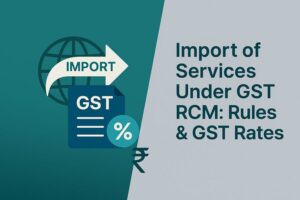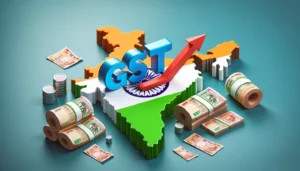Understanding SGST
- 4 Sep 24
- 14 mins

Understanding SGST
Key Takeaways
- SGST simplifies state-level taxation by consolidating multiple indirect taxes into one unified tax.
- Consistent SGST rates across states ensure uniformity in the tax landscape, benefiting businesses and consumers.
- The Input Tax Credit system under SGST helps reduce the overall tax burden on businesses.
- SGST applies to intra-state transactions, while IGST is used for inter-state transactions.
- SGST is essential for generating state revenue, supporting local development and public services.
The State Goods and Services Tax (SGST) is a critical component of India's comprehensive tax structure under the Goods and Services Tax (GST) regime. Introduced as part of the GST framework, SGST is levied by the respective state government on intra-state supplies of goods and services. The introduction of SGST aimed to streamline indirect taxes by integrating various state-level taxes such as Value-Added Tax (VAT), excise duty, entertainment tax, and others into a single, unified tax. This consolidation simplifies the tax landscape, reduces the compliance burden for businesses, and promotes a more straightforward tax collection process.
The SGST is complemented by the Central Goods and Services Tax (CGST) for intra-state transactions and by the Integrated Goods and Services Tax (IGST) for inter-state transactions. The overall GST framework is designed to create a seamless flow of goods and services across the country while ensuring a fair distribution of tax revenues between the central and state governments. This collaborative tax structure aims to eliminate double taxation, enhance the efficiency of tax administration, and support the ease of doing business.
The Purpose of GST
The Goods and Services Tax (GST) was introduced with the primary purpose of unifying India's complex tax system into a single, coherent structure. Before GST, the tax landscape in India was fragmented, with various indirect taxes levied at different stages by both the central and state governments. This dual tax structure created a cascading effect, where taxes were levied on top of taxes, leading to higher costs for businesses and consumers. GST, including SGST, CGST, and IGST, was implemented to address these issues by eliminating the cascading tax effect and ensuring uniformity in tax rates across the country.
GST aims to simplify taxation by reducing the number of tax components businesses must manage, which, in turn, minimizes the compliance burden. By replacing a myriad of central and state taxes, GST has created a more streamlined taxation framework that facilitates easier tax collection and compliance. This new system also promotes transparency and reduces the scope for tax evasion. Additionally, GST is a destination-based tax, meaning it is collected at the point of consumption rather than the point of origin, ensuring a more equitable distribution of tax revenues across states. The implementation of GST represents a significant shift in India's tax policy, aimed at fostering a more business-friendly environment and boosting the country's economic growth.
Key Features of SGST
Streamlined Taxation
One of the most significant features of SGST is the streamlined taxation process it offers. Prior to the implementation of GST, businesses had to navigate a complex web of indirect taxes at both the central and state levels, leading to inefficiencies and a high tax burden. SGST simplifies this process by consolidating various state-level taxes into a single tax, applicable on intra-state supplies of goods and services. This simplification not only reduces the compliance difficulties for businesses but also facilitates easier tax collection and management for the state governments. The introduction of SGST has been pivotal in creating a more straightforward tax structure, promoting the seamless flow of goods and services within a state.
Consistent Tax Rates
SGST ensures consistent tax rates across the states for intra-state transactions, aligning with the broader GST framework's goal of uniformity in taxation. Prior to GST, different states had varying tax rates, which created disparities and complexities in the tax system. SGST addresses this by applying a standard tax rate on goods and services within each state, which is aligned with the CGST Rate imposed by the central government. This uniformity simplifies the taxation framework, reduces the compliance burden for businesses operating in multiple states, and ensures a level playing field across the country. The consistency in tax rates under SGST promotes transparency and fairness in the tax landscape, benefiting both businesses and consumers.
💡If you want to pay your GST with Credit Card, then download Pice Business Payment App. Pice is the one stop app for all paying all your business expenses.
Facilitating Business Operations
SGST plays a crucial role in facilitating business operations by providing a unified and predictable tax environment within each state. By replacing multiple indirect taxes with a single SGST, businesses can focus more on their core activities rather than on managing complex tax compliance requirements. This simplification encourages ease of doing business, as companies no longer have to navigate different tax regimes in each state where they operate. Additionally, the clear guidelines and procedures under SGST reduce the administrative burden and help businesses ensure compliance with state tax laws. This streamlined approach enhances the overall efficiency of business operations and supports economic growth at the state level.
Input Tax Credit System
The Input Tax Credit (ITC) system under SGST is a critical feature that allows businesses to reduce their tax liability by claiming credits for the taxes they have already paid on inputs. This system is designed to eliminate the cascading effect of taxes, where businesses end up paying tax on tax. Under the ITC mechanism, businesses can offset the SGST paid on inputs against the SGST liability on their output, thereby reducing their overall tax burden. This promotes the smooth flow of credits across the supply chain, ensuring that taxes are levied only on the value added at each stage of production. The ITC system under SGST is instrumental in enhancing the efficiency of the tax structure and providing relief to businesses by reducing their tax costs.
Administration and Collection
The administration and collection of SGST are handled by the respective state governments, ensuring that the tax revenues generated from intra-state transactions remain within the state. This decentralized approach allows states to have greater control over their financial resources and better address local development needs. The SGST framework provides clear guidelines for tax collection, filing of returns, and compliance, making it easier for businesses to understand their tax obligations. The integration of digital compliance tools under SGST further streamlines the tax administration process, reducing the scope for errors and enhancing the efficiency of tax collection. This robust administration system supports the effective functioning of the SGST regime and ensures timely revenue collection for the states.
State-Specific Regulations
While SGST is part of the broader GST framework, it allows for state-specific regulations to address the unique needs and circumstances of each state. This flexibility ensures that states can implement certain exemptions, rate revisions, or additional taxes based on their economic and social priorities. For example, states may choose to exempt specific goods and services from SGST to promote certain industries or to support essential public services. This adaptability within the SGST framework allows states to tailor their tax policies to local conditions while still maintaining alignment with the central government's GST framework. This balance between uniformity and flexibility is a key feature of SGST, enabling states to effectively manage their fiscal policies.
Tax Exemptions
SGST provides for various tax exemptions to support specific industries, promote essential goods and services, and address social and economic goals within a state. These exemptions can be state-specific, allowing for targeted relief where needed, such as in sectors like agriculture, healthcare, or education. The exemptions under SGST are designed to reduce the tax burden on consumers and businesses for certain goods and services, thereby encouraging economic activity in these areas. Additionally, SGST exemptions align with the broader GST framework to ensure consistency across the tax system while allowing states to implement policies that reflect their priorities. These exemptions play a crucial role in shaping the tax landscape and ensuring that SGST serves as a tool for economic development and social welfare.
Advantages of SGST
The advantages of SGST are multifaceted, offering benefits to both businesses and state governments. For businesses, SGST simplifies the tax structure by replacing multiple state-level taxes with a single, streamlined tax, reducing the compliance burden and administrative costs. The Input Tax Credit system under SGST further alleviates the tax burden by allowing businesses to claim credits for taxes paid on inputs, which enhances cash flow and supports business growth. Moreover, the consistency in SGST rates across states ensures a uniform tax landscape, reducing discrepancies and creating a level playing field for businesses operating in different states.
For state governments, SGST provides a stable and predictable source of revenue, which is crucial for funding public services and development projects. The decentralized nature of SGST allows states to retain control over their tax revenues, enabling them to address local needs more effectively. Additionally, SGST promotes a fair distribution of tax revenues between the central and state governments, ensuring that states have the financial resources to invest in infrastructure, healthcare, education, and other essential sectors. Overall, SGST plays a pivotal role in enhancing the efficiency of India's tax system, supporting economic growth, and fostering a more equitable distribution of resources.
Illustrative SGST Scenarios
When is SGST Applicable?
SGST is applicable in cases of intra-state transactions, where the supply of goods or services occurs within the same state. This means that both the supplier and the recipient are located in the same state, and the goods or services do not cross state borders. For example, if a business in Madhya Pradesh sells goods to a customer within Madhya Pradesh, SGST is levied on this transaction. The SGST rate applicable is aligned with the CGST Rate, ensuring consistency in taxation across different states. The revenue collected from SGST is retained by the state government, contributing to the state's tax revenues and supporting local development projects.
Intra-State Transactions
Intra-state transactions refer to the supply of goods or services that takes place entirely within a single state. These transactions are subject to both SGST, which goes to the state government, and CGST, which goes to the central government. For instance, if a retailer in Karnataka sells a product to a consumer within Karnataka, the transaction will attract both SGST and CGST. The total GST rate is divided equally between SGST and CGST, providing a balanced revenue distribution between the central and state governments. Intra-state supplies are a significant source of revenue for states, and the SGST collected is used to fund various public services and state-specific projects.
Inter-State Transactions
Inter-state transactions involve the supply of goods or services between different states and are subject to the Integrated Goods and Services Tax (IGST). In these cases, SGST is not applicable. Instead, IGST is levied, which is then shared between the central and respective state governments. For example, if a business in Gujarat supplies goods to a customer in Maharashtra, IGST is charged instead of SGST. The IGST mechanism ensures that the tax burden is appropriately distributed between the states involved in the transaction, promoting fairness and uniformity in the tax system. Inter-state transactions are crucial for maintaining the seamless flow of goods and services across India, supporting the integration of the national economy.
How is SGST Applied?
SGST is applied on the value of goods or services supplied within a state, in conjunction with CGST. The GST rate for a particular item or service is split between SGST and CGST, with each tax component contributing to the overall GST liability. The SGST component is administered and collected by the state government, ensuring that the revenue remains within the state. Businesses are required to charge SGST on taxable supplies made within the state and to file regular returns detailing the tax collected and paid. The Input Tax Credit system under SGST allows businesses to offset the SGST paid on inputs against their SGST liability on outputs, reducing their overall tax burden. This system is designed to simplify tax compliance and support the efficient collection of taxes at the state level.
SGST, CGST, and IGST Rates for Common Items
The rates for SGST, CGST, and IGST are determined based on the applicable GST rate for specific goods and services. These rates are categorized into different slabs, such as 5%, 12%, 18%, and 28%, depending on the nature of the item. For instance, essential goods like food grains may attract a lower GST rate, while luxury items may be taxed at a higher rate. The SGST and CGST rates are typically equal and together make up the total GST rate for intra-state transactions. In the case of inter-state transactions, the IGST rate is equivalent to the combined SGST and CGST rates. The uniform tax rates across states ensure consistency in taxation and simplify the tax compliance process for businesses, contributing to a more predictable and transparent tax system.
 By
By 
















